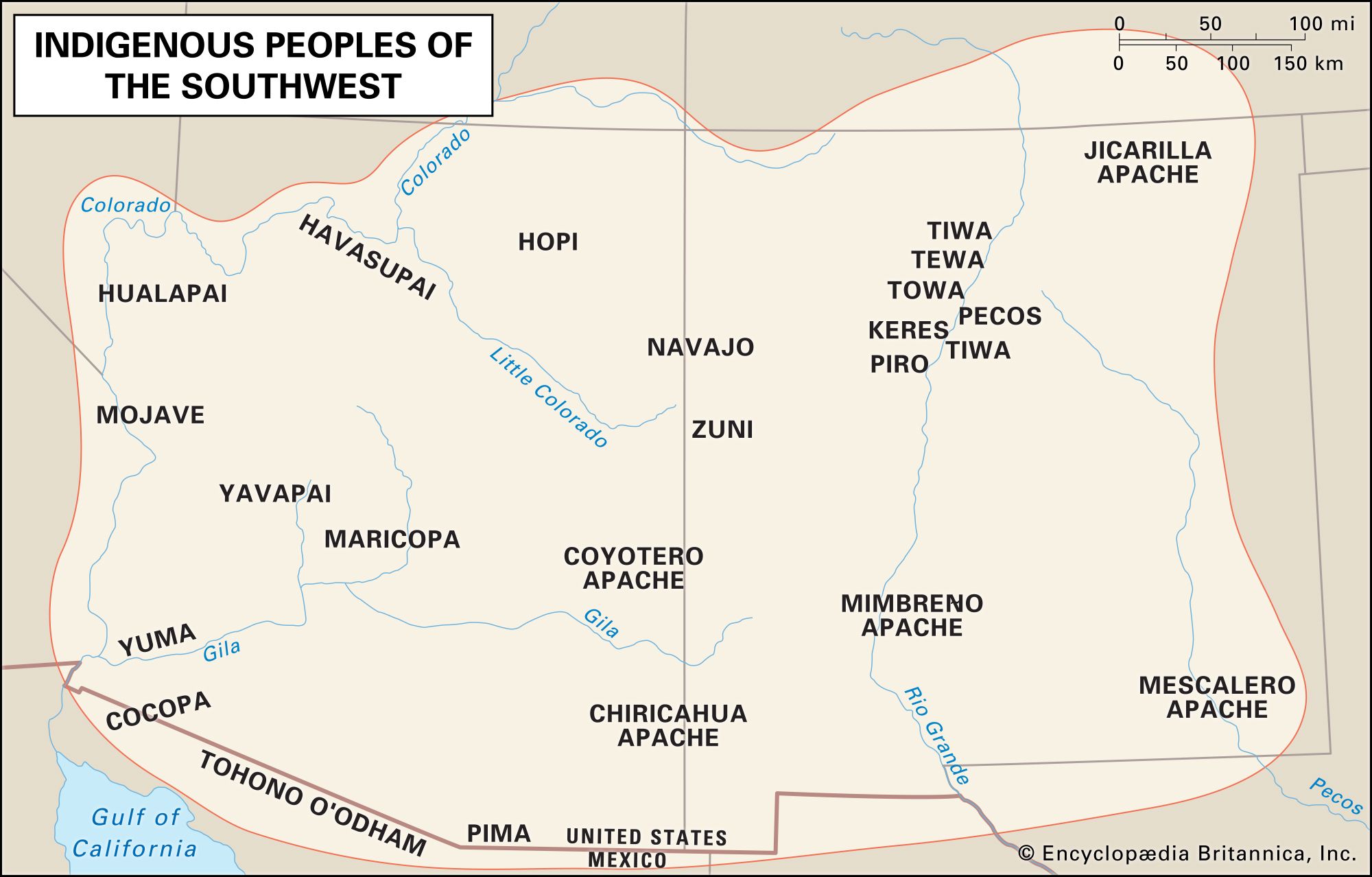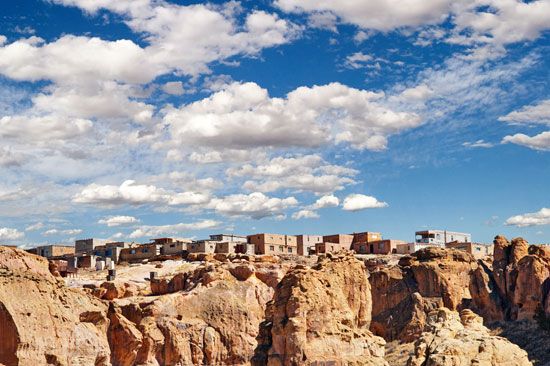Pueblo peoples
- Also called:
- Puebloans
- Key People:
- Elsie Clews Parsons
- Alfred V. Kidder
Where did Pueblo peoples traditionally live?
What was the Pueblo Rebellion?
How is kinship structured in Pueblo communities?
Pueblo peoples, Indigenous North American groups known for living in compact permanent settlements called pueblos. Representative of the Indigenous Southwest culture area, most live in northeastern Arizona and northwestern New Mexico. Population estimates in the early 2020s indicated more than 80,000 individuals of Pueblo descent.
Precontact culture
Pueblo peoples are thought to be the descendants of the prehistoric Ancestral Pueblo (Anasazi) culture. Just as there was considerable regional diversity among the Ancestral Puebloans, there is similar diversity, both cultural and linguistic, among the contemporary Pueblo peoples. Contemporary Puebloans are customarily described as belonging to either the eastern or the western division. The eastern Pueblo villages are in New Mexico along the Rio Grande and comprise groups who speak Tanoan and Keresan languages. Tanoan languages such as Tewa are distantly related to Uto-Aztecan, but Keresan has no known affinities. The western Pueblo villages include the Hopi villages of northern Arizona and the A:Shiwi, Acoma, and Laguna villages, all in western New Mexico. Of the western Pueblo peoples, Acoma and Laguna speak Keresan; the A:Shiwi speak a language of Penutian affiliation; and the Hopi, with one exception, speak Hopi, a Uto-Aztecan language. The exception is the village of Hano, composed of Tewa refugees from the Rio Grande.
Each of the 70 or more Pueblo villages extant before Spanish colonization was politically autonomous, governed by a council composed of the heads of religious societies. Those societies were centered in the kivas, subterranean ceremonial chambers that also functioned as private clubs and lounging rooms for men. Traditionally, Pueblo peoples were farmers, with the types of farming and associated traditions of property ownership varying among the groups. Along the Rio Grande and its tributaries, corn (maize) and cotton were cultivated in irrigated fields in river bottoms. Among the western Puebloans, especially the Hopi, farming was less reliable because there were few permanent water sources. Traditionally, women did most of the farming, but as hunting diminished in importance, men also became responsible for agricultural work. Many of the Rio Grande Puebloans had special hunting societies that hunted deer and antelope in the mountains, and easterly Puebloans such as the Taos and Picuris sometimes sent hunters to the Plains for bison. Among all Pueblo peoples, communal rabbit hunts were held, and women gathered wild plants to eat.

After European contact
In 1539 a Franciscan friar, Marcos de Niza, claimed the Pueblo region for Spain. Explorer Francisco Vázquez de Coronado followed in 1540, quickly and brutally pacifying all Indigenous resistance. In 1680 a Tewa man, Popé, led the Pueblo Rebellion against the Spanish. The colonizers retreated from the region for several years but completed a reconquest in 1692. Subsequently, most villages adapted to colonial rule through syncretism, adopting and incorporating those aspects of the dominant culture necessary for survival under its regime, while maintaining the basic fabric of traditional culture. Historical examples of Pueblo syncretism include the addition of sheep and shepherding to the agricultural economy and the adoption of some Christian religious practices.
Contemporary Pueblo peoples continue to use syncretic strategies; they have adopted a variety of modern convenience products, yet they extensively retain their traditional kinship systems, religions, and crafts. Social life centers on the village, which is also the primary political unit. Kinship plays a fundamental role in social and religious life in 21st-century Pueblo communities; it may delimit an individual’s potential marriage partners and often determines eligibility for membership in religious societies and a wide variety of social and economic obligations. Kinship is typically reckoned through the lineage, a group that shares a common ancestor; several lineages together form a clan. Early 20th-century kinship studies indicated that some pueblos may have had more than 30 clans at one time, which were often grouped into two larger units, or moieties. The clans of the eastern Pueblos are organized into complementary moieties, known respectively as the Summer people and the Winter people (Tanoans) or as the Turquoise people and the Squash people. These groups alternate responsibility for pueblo activities, and their secret societies deal primarily with curing rituals. In contrast, the western Puebloans are organized into several matrilineal lineages and clans; secret societies, each controlled by a particular clan, perform a calendrical cycle of rituals to ensure rain and tribal welfare. Many Pueblo peoples continue to practice the kachina (katsina) religion, a complex belief system in which hundreds of divine beings act as intermediaries between humans and God.


















